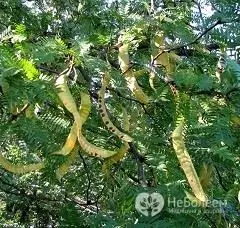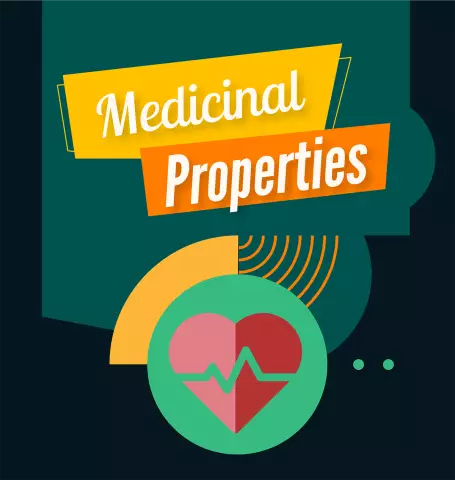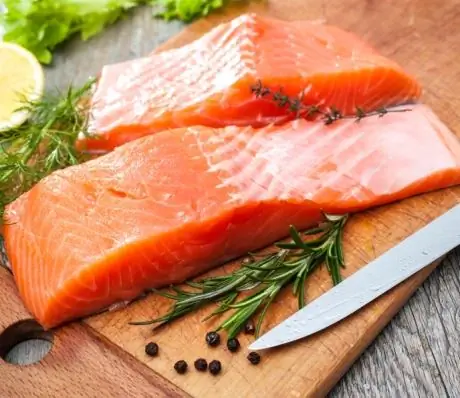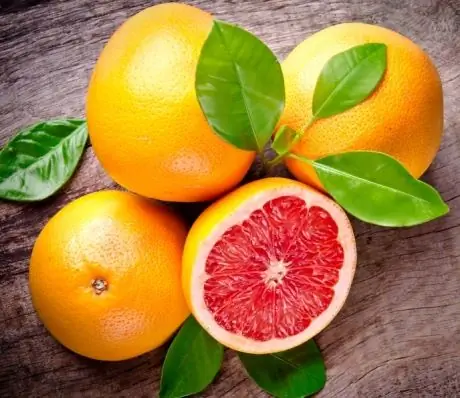- Author Rachel Wainwright [email protected].
- Public 2023-12-15 07:39.
- Last modified 2025-11-02 20:14.
Gledicia
Instructions for use:
- 1. Chemical composition
- 2. Useful properties
- 3. Indications for use
- 4. Contraindications
- 5. Home remedies

Gleditsia (synonym - three-prickled gledicia) is a large tree growing up to 45 meters in height, belonging to the genus Gleditsia (Gleditsia) of the Caesalpiniaceae family.
The most common is common gledichia. Has a wide openwork crown and dark brown bark. The trunk and branches are completely covered with reddish-brown branching or simple spines 20-30 cm long. The leaves are alternate, paired or double-peeled. Small greenish flowers are located in dense axillary racemes. The homeland of the plant is the eastern part of North America, but it is cultivated in all countries with a temperate climate. Currently, it is actively grown in the southern regions of the European part of Russia, in particular in the Rostov region, in the south of the Volga region, in the Krasnodar Territory and in the North Caucasus.
Gledicia is a poisonous plant. Possesses decorative and medicinal properties, is a good honey plant.
Chemical composition
The young leaves and flowers of gleditsia contain the alkaloid triacanthin.
Leaves and fruits contain ascorbic acid (from 100 to 400 mg).
The beans contain sugars, 3-glucoside-1-epicatechin, saponins and flavone compounds (including fustin, olmelin, acrammerin and fisetin).
The pods contain tannins, anthraglycosides, traces of vitamin K.
Beneficial features
The main active substance, which is found mainly in young leaves of the tree, is the alkaloid triacanthin:
- has a pronounced antispasmodic effect on organs with smooth muscles;
- stimulates the respiratory center;
- stimulates breathing;
- dilates blood vessels;
- enhances coronary circulation;
- lowers blood pressure.
Anthraglycosides contained in fruit valves have a laxative effect.
Indications for use
Gledicia is not included in the State Pharmacopoeia of the Russian Federation and is not used in official medicine. However, young leaves of the plant are used as a raw material for the production of the alkaloid triacanthin (Triacanthinum), and hydrochloric acid of the alkaloid triacanthine hydrochloride is widely used in medicine as an antispasmodic for spasms of smooth muscles of the intestines, stomach and bronchi.
In folk medicine, a decoction of fruits and leaves is used to treat chronic constipation, spastic colitis, chronic gastritis, chronic inflammation of the gallbladder, gastric ulcer and duodenal ulcer.
Bean leaves are used as a laxative.
Contraindications
- age up to 15 years;
- pregnancy;
- lactation period;
- increased individual sensitivity to the plant.
With caution, preparations based on gledicia should be used for people with low blood pressure.
Gledicia is a poisonous plant! It is strictly forbidden to exceed the recommended doses, since toxic glycosides in case of an overdose can cause salivation, nausea, vomiting, diarrhea, pale skin, hypotension, drowsiness, fainting. In severe cases, possible: degenerative changes in the liver, pneumonia, hemolysis of erythrocytes, congestion in the brain, etc.
Home remedies from Hledicia
- a decoction for the treatment of gastritis and peptic ulcer: chop 10 g of beans and pour 500 ml of hot water, bring to a boil and boil for 10 minutes over low heat, leave for 3 hours. Take 1 tbsp. l. 5 times a day for 2 weeks;
- remedy for inflammation of the gallbladder: 1 tbsp. l. chop the dried leaves, pour into an enamel container, pour a glass (250 ml) of hot water, boil in a water bath for 30 minutes, cool and strain, bring the volume to the original with boiled water. Take 1 tbsp. l. half an hour before meals;
- infusion for constipation: pour 10 g of beans shutters with 1 glass of boiling water, insist, strain, squeeze out the raw material for 15 minutes. Take 1 tbsp. l. up to 4 times a day.
Information about the drug is generalized, provided for informational purposes only and does not replace the official instructions. Self-medication is hazardous to health!






